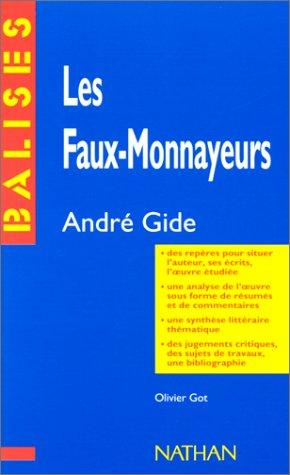Livre broché, 128 pages
Langue : French
Publié par Cle International, Nathan.

Livre broché, 128 pages
Langue : French
Publié par Cle International, Nathan.
The Counterfeiters (French: Les Faux-monnayeurs) is a 1925 novel by French author André Gide, first published in Nouvelle Revue Française. With many characters and crisscrossing plotlines, its main theme is that of the original and the copy, and what differentiates them – both in the external plot of the counterfeit gold coins and in the portrayal of the characters' feelings and their relationships. The Counterfeiters is a novel-within-a-novel, with Édouard (the alter ego of Gide) intending to write a book of the same title. Other stylistic devices are also used, such as an omniscient narrator who sometimes addresses the reader directly, weighs in on the characters' motivations or discusses alternate realities. Therefore, the book has been seen as a precursor of the nouveau roman. The structure of the novel was written to mirror "Cubism", in that it interweaves between several different plots and portrays multiple points of view.
The …
The Counterfeiters (French: Les Faux-monnayeurs) is a 1925 novel by French author André Gide, first published in Nouvelle Revue Française. With many characters and crisscrossing plotlines, its main theme is that of the original and the copy, and what differentiates them – both in the external plot of the counterfeit gold coins and in the portrayal of the characters' feelings and their relationships. The Counterfeiters is a novel-within-a-novel, with Édouard (the alter ego of Gide) intending to write a book of the same title. Other stylistic devices are also used, such as an omniscient narrator who sometimes addresses the reader directly, weighs in on the characters' motivations or discusses alternate realities. Therefore, the book has been seen as a precursor of the nouveau roman. The structure of the novel was written to mirror "Cubism", in that it interweaves between several different plots and portrays multiple points of view.
The novel features a considerable number of bisexual or gay male characters – the adolescent Olivier and at least to a certain unacknowledged degree his friend Bernard, in all likelihood their schoolfellows Gontran and Philippe, and finally the adult writers the Comte de Passavant (who represents an evil and corrupting force) and the (more benevolent) Édouard. An important part of the plot is its depiction of various possibilities of positive and negative homoerotic or homosexual relationships.
Initially received coldly on its appearance, perhaps because of its homosexual themes and its unusual composition, The Counterfeiters has gained reputation in the intervening years and is now generally counted among the Western canon of literature.